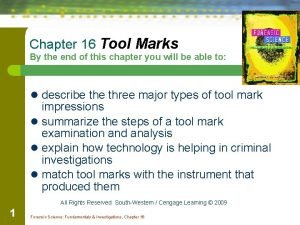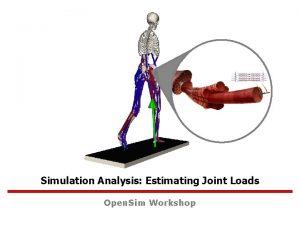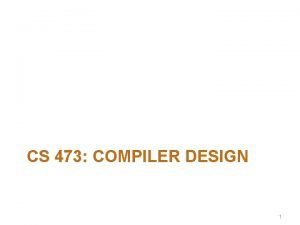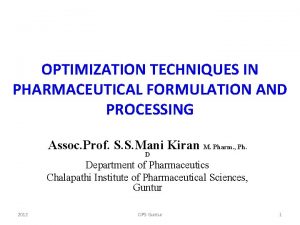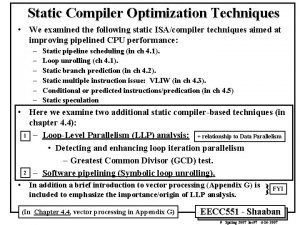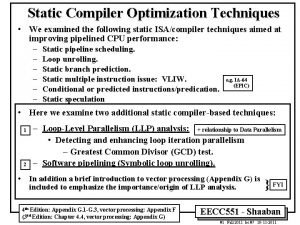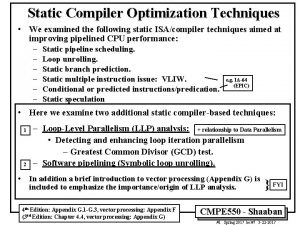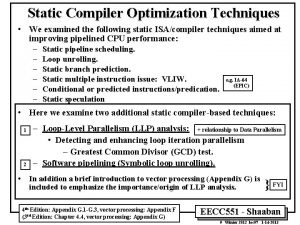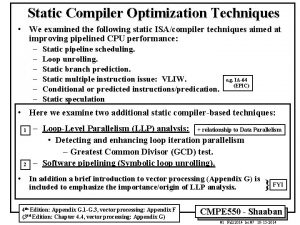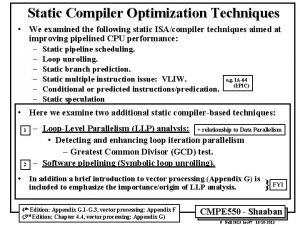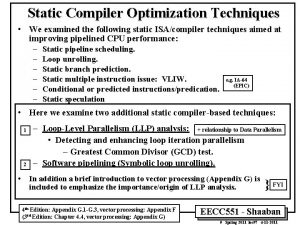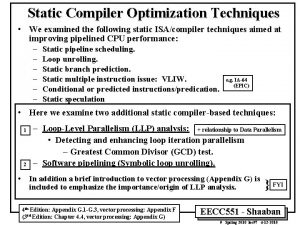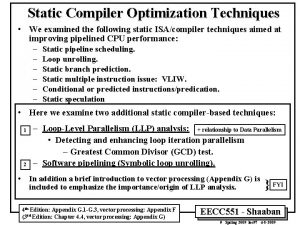Static Compiler Optimization Techniques We already examined the


![LLP Analysis Example 1 • In the loop: for (i=1; i<=100; i=i+1) { A[i+1] LLP Analysis Example 1 • In the loop: for (i=1; i<=100; i=i+1) { A[i+1]](https://slidetodoc.com/presentation_image_h/327d85be58efb0d51b980f08a00c6630/image-3.jpg)

![LLP Analysis Example 2 Original Loop: Iteration 1 for (i=1; i<=100; i=i+1) { A[i] LLP Analysis Example 2 Original Loop: Iteration 1 for (i=1; i<=100; i=i+1) { A[i]](https://slidetodoc.com/presentation_image_h/327d85be58efb0d51b980f08a00c6630/image-5.jpg)





- Slides: 10

Static Compiler Optimization Techniques • We already examined the following static compiler techniques aimed at improving pipelined CPU performance: – Static pipeline scheduling (in ch 4. 1). – Loop unrolling (ch 4. 1). – Static branch prediction (in ch 4. 2). – Static multiple instruction issue: VLIW (in ch 4. 3). – Conditional or predicted instructions (in ch 4. 5) • Here we examine two additional static compiler-based techniques (in ch 4. 4): – Loop-Level Parallelism (LLP) analysis: • Detecting and enhancing loop iteration parallelism – GCD test. – Software pipelining (Symbolic loop unrolling). (In Chapter 4. 4) EECC 551 - Shaaban # Winter 2002 lec#7 1 -13 -2003

Loop-Level Parallelism (LLP) Analysis • Loop-Level Parallelism (LLP) analysis focuses on whether data accesses in later iterations of a loop are data dependent on data values produced in earlier iterations. e. g. in for (i=1; i<=1000; i++) x[i] = x[i] + s; the computation in each iteration is independent of the previous iterations and the loop is thus parallel. The use of X[i] twice is within a single iteration. ÞThus loop iterations are parallel (or independent from each other). • Loop-carried Dependence: A data dependence between different loop iterations (data produced in earlier iteration used in a later one). • LLP analysis is normally done at the source code level or close to it since assembly language and target machine code generation introduces a loop-carried name dependence in the registers used for addressing and incrementing. • Instruction level parallelism (ILP) analysis, on the other hand, is usually done when instructions are generated by the compiler. EECC 551 - Shaaban # Winter 2002 lec#7 1 -13 -2003
![LLP Analysis Example 1 In the loop for i1 i100 ii1 Ai1 LLP Analysis Example 1 • In the loop: for (i=1; i<=100; i=i+1) { A[i+1]](https://slidetodoc.com/presentation_image_h/327d85be58efb0d51b980f08a00c6630/image-3.jpg)
LLP Analysis Example 1 • In the loop: for (i=1; i<=100; i=i+1) { A[i+1] = A[i] + C[i]; /* S 1 */ B[i+1] = B[i] + A[i+1]; } /* S 2 */ } (Where A, B, C are distinct non-overlapping arrays) – S 2 uses the value A[i+1], computed by S 1 in the same iteration. This data dependence is within the same iteration (not a loop-carried dependence). Þ does not prevent loop iteration parallelism. – S 1 uses a value computed by S 1 in an earlier iteration, since iteration i computes A[i+1] read in iteration i+1 (loop-carried dependence, prevents parallelism). The same applies for S 2 for B[i] and B[i+1] ÞThese two dependences are loop-carried spanning more than one iteration preventing loop parallelism. EECC 551 - Shaaban # Winter 2002 lec#7 1 -13 -2003

• In the loop: LLP Analysis Example 2 for (i=1; i<=100; i=i+1) { A[i] = A[i] + B[i]; B[i+1] = C[i] + D[i]; /* S 1 */ /* S 2 */ } – S 1 uses the value B[i] computed by S 2 in the previous iteration (loopcarried dependence) – This dependence is not circular: • S 1 depends on S 2 but S 2 does not depend on S 1. – Can be made parallel by replacing the code with the following: A[1] = A[1] + B[1]; Loop Start-up code for (i=1; i<=99; i=i+1) { B[i+1] = C[i] + D[i]; A[i+1] = A[i+1] + B[i+1]; } B[101] = C[100] + D[100]; Loop Completion code EECC 551 - Shaaban # Winter 2002 lec#7 1 -13 -2003
![LLP Analysis Example 2 Original Loop Iteration 1 for i1 i100 ii1 Ai LLP Analysis Example 2 Original Loop: Iteration 1 for (i=1; i<=100; i=i+1) { A[i]](https://slidetodoc.com/presentation_image_h/327d85be58efb0d51b980f08a00c6630/image-5.jpg)
LLP Analysis Example 2 Original Loop: Iteration 1 for (i=1; i<=100; i=i+1) { A[i] = A[i] + B[i]; B[i+1] = C[i] + D[i]; } Iteration 2 A[1] = A[1] + B[1]; A[2] = A[2] + B[2]; B[2] = C[1] + D[1]; B[3] = C[2] + D[2]; . . . Loop-carried Dependence Iteration 99 Iteration 100 A[99] = A[99] + B[99]; A[100] = A[100] + B[100]; B[100] = C[99] + D[99]; B[101] = C[100] + D[100]; A[1] = A[1] + B[1]; for (i=1; i<=99; i=i+1) { B[i+1] = C[i] + D[i]; A[i+1] = A[i+1] + B[i+1]; } B[101] = C[100] + D[100]; Modified Parallel Loop: Loop Start-up code /* S 1 */ /* S 2 */ Iteration 1 A[1] = A[1] + B[1]; A[2] = A[2] + B[2]; B[2] = C[1] + D[1]; B[3] = C[2] + D[2]; . . Not Loop Carried Dependence Iteration 98 Iteration 99 A[99] = A[99] + B[99]; A[100] = A[100] + B[100]; B[100] = C[99] + D[99]; B[101] = C[100] + D[100]; Loop Completion code EECC 551 - Shaaban # Winter 2002 lec#7 1 -13 -2003

ILP Compiler Support: Loop-Carried Dependence Detection • Compilers can increase the utilization of ILP by better detection of instruction dependencies. • To detect loop-carried dependence in a loop, the GCD test can be used by the compiler, which is based on the following: • If an array element with index: a x i + b is stored and element: c x i + d of the same array is loaded where index runs from m to n, a dependence exist if the following two conditions hold: 1 There are two iteration indices, j and k , m £ j , K £ n (within iteration limits) 2 The loop stores into an array element indexed by: a x j +b and later loads from the same array the element indexed by: c x k + d Thus: a x j + b = c x k + d EECC 551 - Shaaban # Winter 2002 lec#7 1 -13 -2003

The Greatest Common Divisor (GCD) Test • If a loop carried dependence exists, then : GCD(c, a) must divide (d-b) Example: Index of element stored: for(i=1; i<=100; i=i+1) { x[2*i+3] = x[2*i] * 5. 0; } a=2 b=3 c=2 GCD(a, c) = 2 d - b = -3 a x i +b Index of element loaded: c x i + d d=0 2 does not divide -3 Þ No dependence possible. EECC 551 - Shaaban # Winter 2002 lec#7 1 -13 -2003

ILP Compiler Support: Software Pipelining (Symbolic Loop Unrolling) – A compiler technique where loops are reorganized: • Each new iteration is made from instructions selected from a number of iterations of the original loop. – The instructions are selected to separate dependent instructions within the original loop iteration. – No actual loop-unrolling is performed. – A software equivalent to the Tomasulo approach. – Requires: • Additional start-up code to execute code left out from the first original loop iterations. • Additional finish code to execute instructions left out from the last original loop iterations. EECC 551 - Shaaban # Winter 2002 lec#7 1 -13 -2003

Software Pipelining: Symbolic Loop Unrolling EECC 551 - Shaaban # Winter 2002 lec#7 1 -13 -2003

Software Pipelining Example overlapped ops Before: Unrolled 3 times After: Software Pipelined 1 L. D F 0, 0(R 1) 1 S. D F 4, 0(R 1) ; Stores M[i] 2 ADD. D F 4, F 0, F 2 ; Adds to M[i-1] 3 S. D F 4, 0(R 1) 3 L. D F 0, -16(R 1); Loads M[i-2] 4 L. D F 6, -8(R 1) 4 DADDUI R 1, #-8 5 ADD. D F 8, F 6, F 2 5 BNE R 1, R 2, LOOP 6 S. D F 8, -8(R 1) Software Pipeline 7 L. D F 10, -16(R 1) 8 ADD. D F 12, F 10, F 2 9 S. D F 12, -16(R 1) Time 10 DADDUI R 1, #-24 Loop Unrolled 11 BNE R 1, R 2, LOOP Time EECC 551 - Shaaban # Winter 2002 lec#7 1 -13 -2003
 Already can or can already
Already can or can already Which of the following is machine independent language
Which of the following is machine independent language Lex yacc example
Lex yacc example Cross compiler in compiler design
Cross compiler in compiler design What is conflict theory
What is conflict theory Abrasion mark
Abrasion mark Opensim static optimization
Opensim static optimization Static single assignment
Static single assignment Type checking in compiler construction
Type checking in compiler construction Static single assignment form
Static single assignment form Optimization techniques in pharmaceutical formulation
Optimization techniques in pharmaceutical formulation





